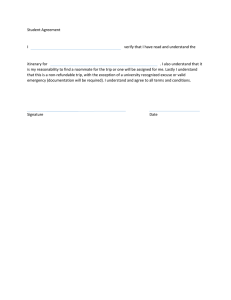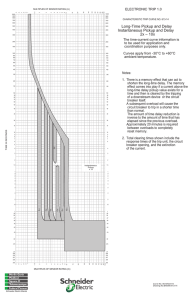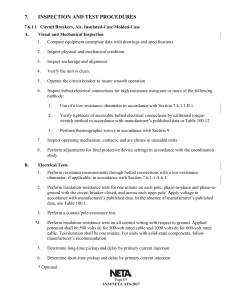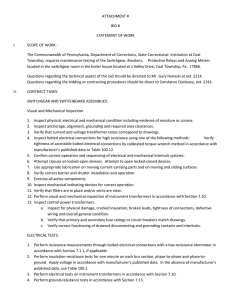inspection and test procedures
advertisement
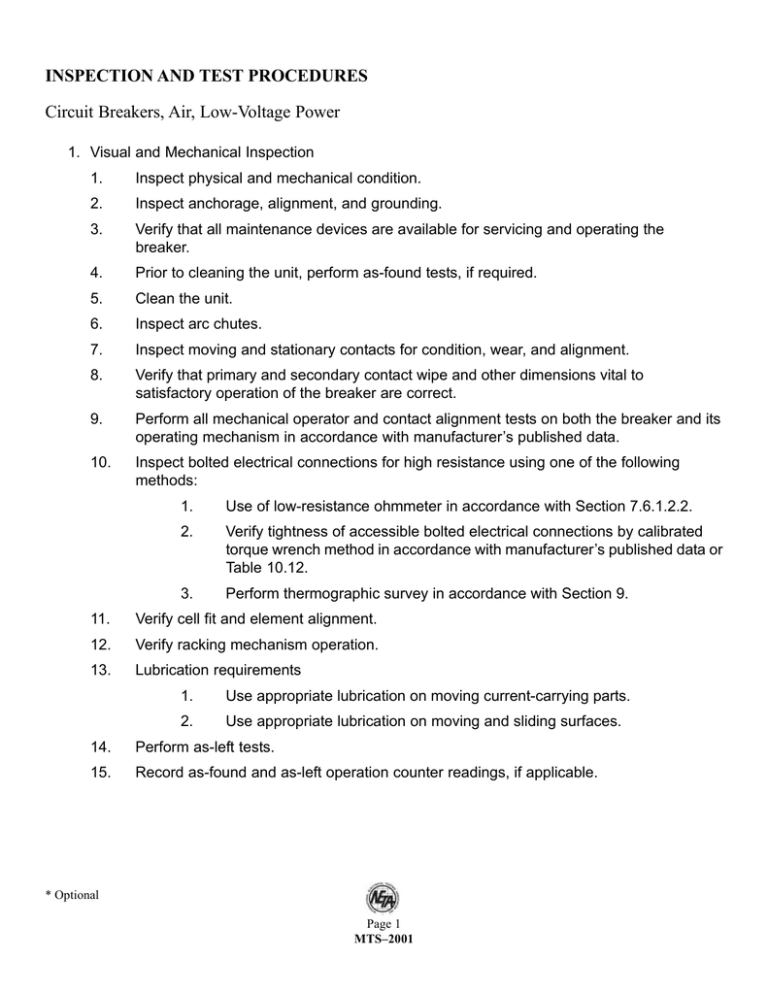
INSPECTION AND TEST PROCEDURES Circuit Breakers, Air, Low-Voltage Power 1. Visual and Mechanical Inspection 1. Inspect physical and mechanical condition. 2. Inspect anchorage, alignment, and grounding. 3. Verify that all maintenance devices are available for servicing and operating the breaker. 4. Prior to cleaning the unit, perform as-found tests, if required. 5. Clean the unit. 6. Inspect arc chutes. 7. Inspect moving and stationary contacts for condition, wear, and alignment. 8. Verify that primary and secondary contact wipe and other dimensions vital to satisfactory operation of the breaker are correct. 9. Perform all mechanical operator and contact alignment tests on both the breaker and its operating mechanism in accordance with manufacturer’s published data. 10. Inspect bolted electrical connections for high resistance using one of the following methods: 1. Use of low-resistance ohmmeter in accordance with Section 7.6.1.2.2. 2. Verify tightness of accessible bolted electrical connections by calibrated torque wrench method in accordance with manufacturer’s published data or Table 10.12. 3. Perform thermographic survey in accordance with Section 9. 11. Verify cell fit and element alignment. 12. Verify racking mechanism operation. 13. Lubrication requirements 1. Use appropriate lubrication on moving current-carrying parts. 2. Use appropriate lubrication on moving and sliding surfaces. 14. Perform as-left tests. 15. Record as-found and as-left operation counter readings, if applicable. * Optional Page 1 MTS–2001 INSPECTION AND TEST PROCEDURES (CONTINUED) Circuit Breakers, Air, Low-Voltage Power 2. Electrical Tests 1. Perform resistance measurements through bolted connections with a low-resistance ohmmeter, if applicable, in accordance with Section 7.6.1.2.1. 2. Perform insulation-resistance tests on each pole, phase-to-phase and phase-to-ground with the circuit breaker closed and across each open pole for one minute. Test voltage shall be in accordance with manufacturer’s published data or Table 10.1. 3. Perform a contact/pole-resistance test. *4. Perform insulation-resistance tests on all control wiring with respect to ground. Applied potential shall be 500 volts dc for 300 volt rated cable and 1000 volts dc for 600 volt rated cable. Test duration shall be one minute. For units with solid-state components, follow manufacturer’s recommendation. 5. Make adjustments to the trip settings in accordance with the coordination study. 6. Determine minimum pickup current by primary current injection. 7. Determine long-time delay by primary current injection. 8. Determine short-time pickup and delay by primary current injection. 9. Determine ground-fault pickup and delay by primary current injection. 10. Determine instantaneous pickup value by primary current injection. *11. Test functions of the trip unit by means of secondary injection. 12. Activate auxiliary protective devices, such as ground-fault or undervoltage trip devices, to insure operation of shunt trip devices. Check the operation of electrically-operated breakers in their cubicles. 13. Perform minimum pickup voltage test on shunt trip and close coils in accordance with Table 10.20. 14. Verify correct operation of any auxiliary features such as trip and pickup indicators, zone interlocking, electrical close and trip operation, trip-free, antipump function, trip unit battery condition, and reset all trip logs and indicators. 15. Verify operation of charging mechanism. * Optional Page 2 MTS–2001 INSPECTION AND TEST PROCEDURES (CONTINUED) Circuit Breakers, Air, Low-Voltage Power 3. Test Values 1. Compare bolted connection resistances to values of similar connections. 2. Bolt-torque levels should be in accordance with Table 10.12 unless otherwise specified by the manufacturer. 3. Microhm or millivolt drop values shall not exceed the high levels of the normal range as indicated in the manufacturer’s published data. If manufacturer’s data is not available, investigate any values which deviate from adjacent poles or similar breakers by more than 50 percent of the lowest value. 4. Circuit breaker insulation resistance should be in accordance with Table 10.1. 5. Control wiring minimum insulation-resistance values should be comparable to previously obtained results but not less than two megohms. 6. Trip characteristics of breakers should fall within manufacturer’s published timecurrent tolerance bands. 7. Minimum pickup voltage on shunt trip and close coils should be in accordance with manufacturer’s published data. In the absence of manufacturer’s published data, refer to Table10.20. * Optional Page 3 MTS–2001
